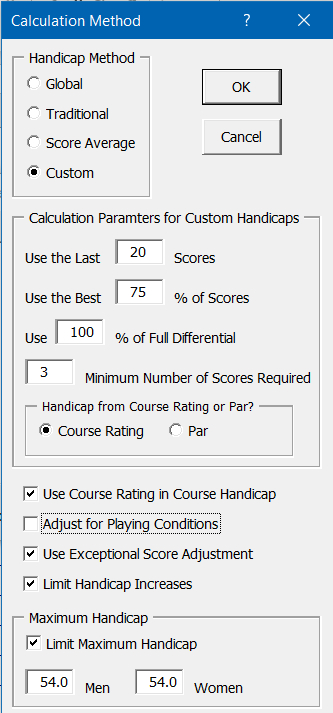Handicap Calculation Method
Whether you are providing handicap services for several golf clubs, or just looking to keep the matches fair among your golfing buddies, you can define a handicap calculation method that works best for your needs. When you click the Calculate Handicaps button, the Calculate Handicaps form will appear. The current calculation method is displayed in the frame below the Calculation Method button.
Click the Calculation Method button to change or modify the method you want to use. The program has three built-in calculation methods and also lets you define a custom calculation method. The Global Handicap and the Traditional Handicap methods are the fairest methods. The Global Handicap method is very similar to the World Handicap System™, which is used around the world. The Traditional Handicap method, which is also very fair, is very similar to the USGA Handicap System™ that was used in the United States and some other countries before 2020. You can also choose the Score Average method, which averages the differentials between the scores posted and par for each of the last 20 rounds played. This is the most basic handicapping method and is often used by golf leagues.
If none of these methods suit your needs, you can define your own calculation method. Just select the "Custom" option and enter the custom settings in the "Calculation Parameters for Custom Handicaps" section of the form. In addition, you can also customize some options in the Global Handicap method.

There are five different parameters and five optional components to define for a custom handicap. The first parameter is how many scores to consider in the calculation: "Use the Last ___ Scores".
The second parameter defines what percentage of the scores considered are actually used in the calculation: "Use the Best ___% of Scores". For example: If you set this number at 50% and you were using the last 10 scores, only the best 5 of the 10 most recent differentials would be used to calculate the handicap.
The third parameter defines what percent of the full average differential you want to use for calculating the final handicap index: "Use ___% of full differential". Using the example above, if the player's best five differentials were 10, 12, 14, 16, & 18 and you were using 90% of full differential, the players handicap index would calculate as follows: the full average differential would be 14.0, therefore the players handicap index would be 14.0 x 90% = 12.6.
The fourth parameter is the minimum number of scores required before a handicap is considered valid. This can be set to insure that a golfer has played enough rounds for his handicap to be representative of his scoring ability. The Traditional method requires at least three scores but you can make it whatever you desire when defining your custom handicap method.
The last parameter is whether the handicap should be calculated based on the differential from par or from the course rating. Once you set the custom handicap parameters once, Handicap Manager for Excel remembers the settings so there is no need to set them again unless you want to make changes.
If you are using the Global or Custom calculation option, there are four additional options available. Below are brief descriptions. Just click the links for a more detailed explanation of each option. (The first two options are not available if you are using a Custom calculation and are handicapping from par.)
Use Course Rating in Course Handicap is a recommended feature that incorporates the course rating relative to par into the course handicap calculation. It is turned on by default.
Playing Conditions Compensation (PCC) is a feature that adjusts handicap differentials to compensate for unusually difficult or easy playing conditions. It is turned off by default.
Use Exceptional Score Adjustment (ESA) is a recommended feature that lowers a player's handicap if an exceptionally good score is posted. It is turned on by default.
Limit Handicap Increases is a recommended feature that limits how quickly and how far a player's handicap can increase. It is turned on by default.
An option is provided to limit the maximum handicap for men and women. Select the "Limit Maximum Handicap" check box and enter the desired maximum numbers in the appropriate fields. The Traditional Handicap option sets a maximum Handicap Index for both men and women at 54. (For Nine-Hole Handicaps, the maximum is 27.) If you are using the Traditional Handicap calculation method, you cannot set the Maximum Handicap below the Traditional maximum. You can allow Handicaps greater than the Traditional maximum but they will be designated as Local "L" Handicaps, which the program will take care of automatically.
Please keep in mind when setting maximum Handicaps, that only the Handicap Index is limited. Depending on the course being played, it is possible for the Course Handicap to exceed the maximum Handicap Index. Once you've selected the handicap calculation method (and defined the custom handicap parameters if necessary), click OK to return to the Handicap Calculation form. The program will automatically save your handicap calculation selection along with any custom handicap parameters.
Visit Checkbook on Facebook
Visit Handicap Manager on Facebook